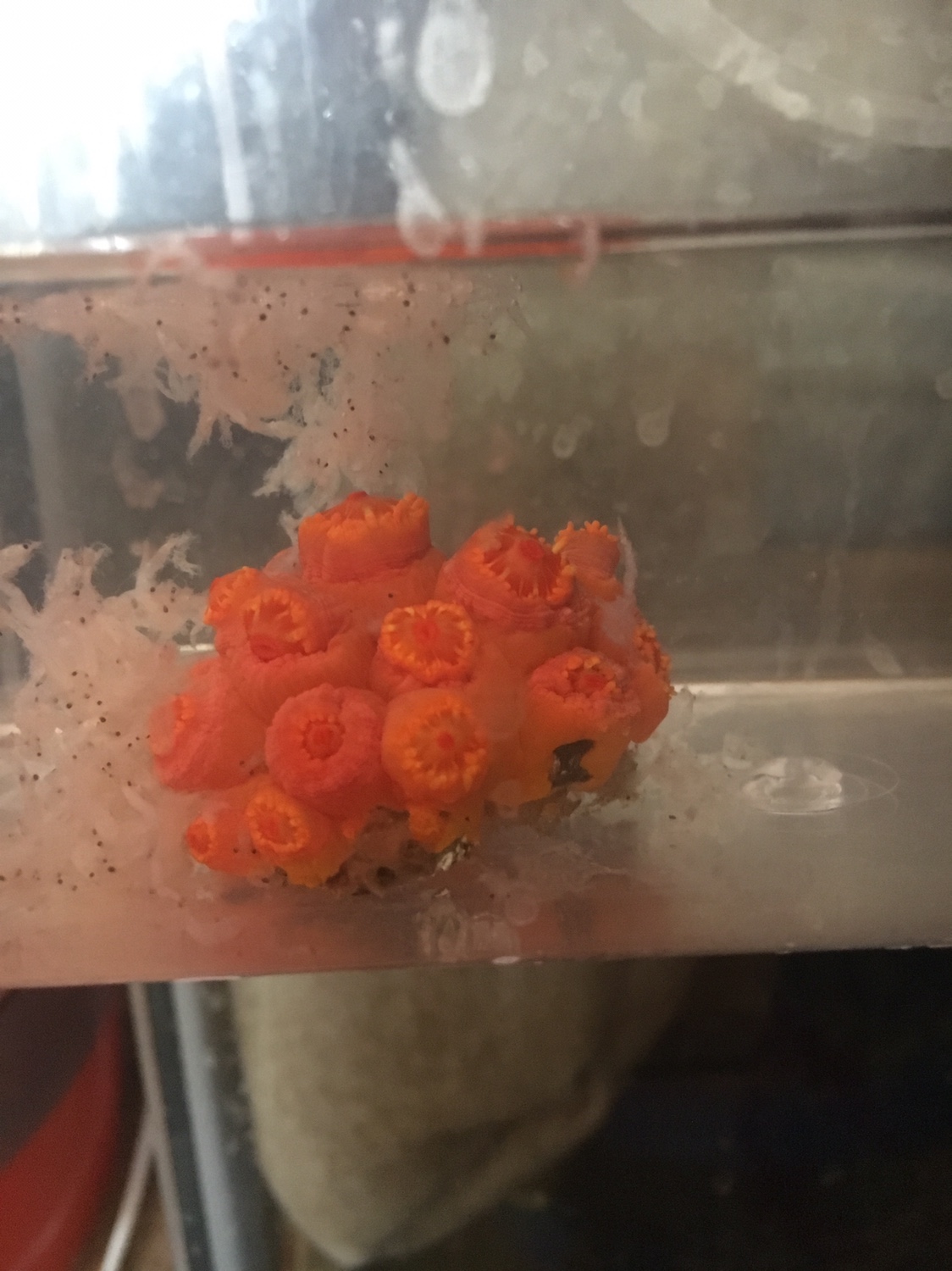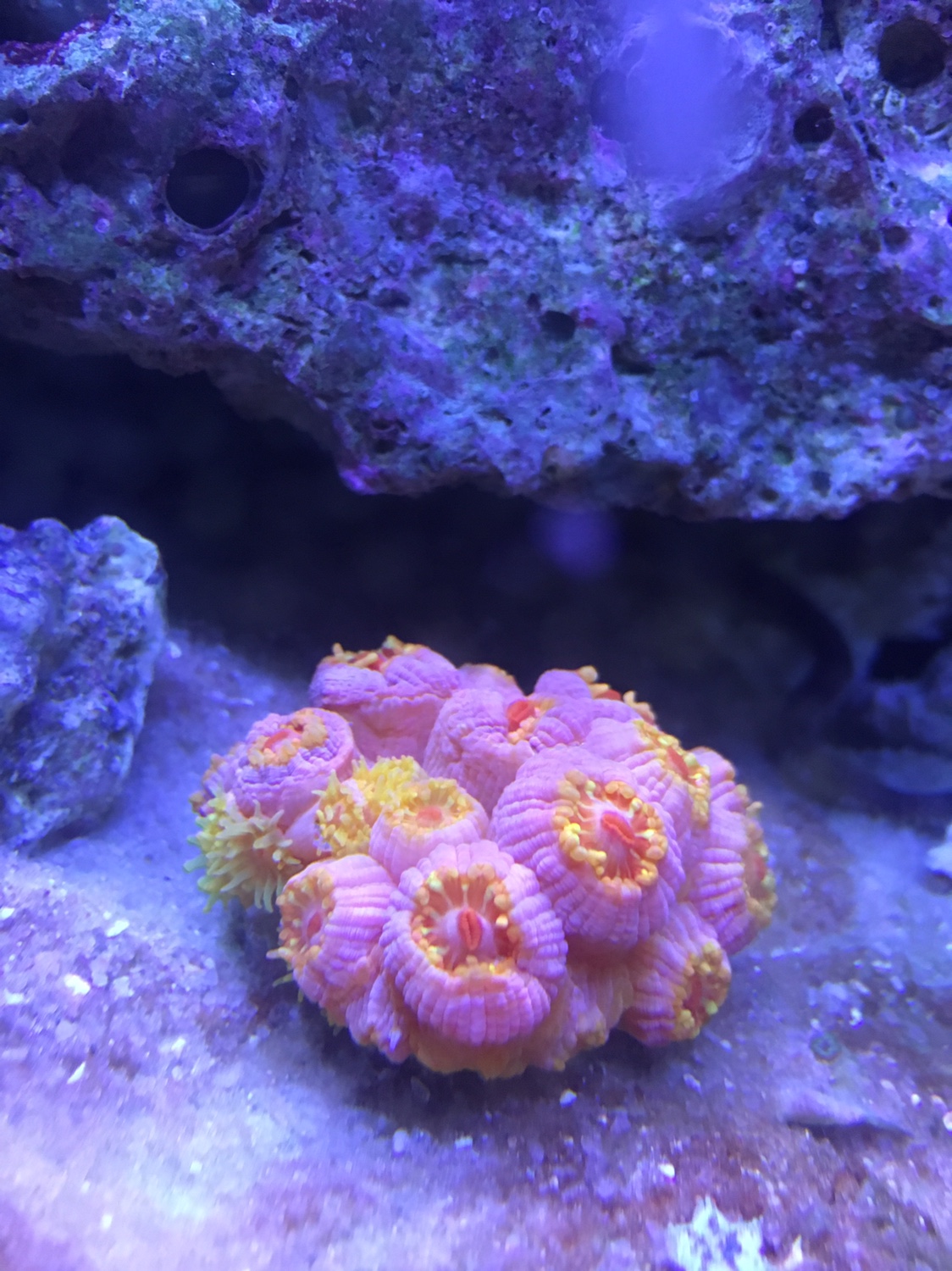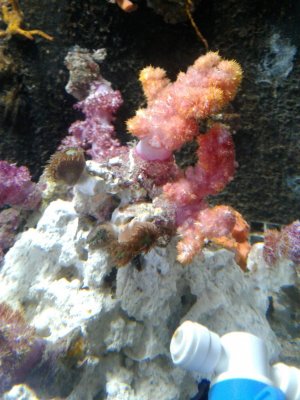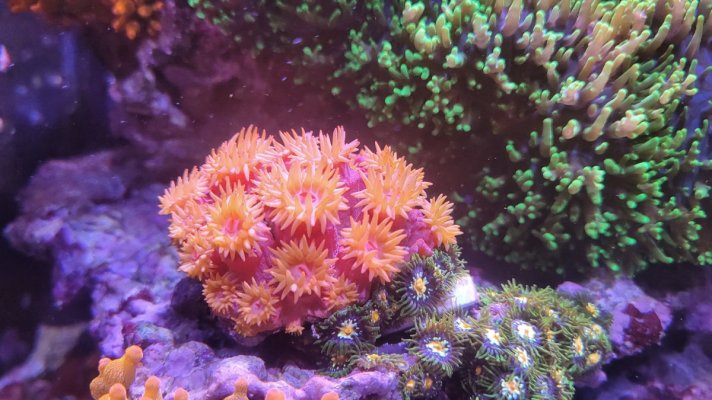Navigation
Install the app
How to install the app on iOS
Follow along with the video below to see how to install our site as a web app on your home screen.
Note: This feature may not be available in some browsers.
More options
You are using an out of date browser. It may not display this or other websites correctly.
You should upgrade or use an alternative browser.
You should upgrade or use an alternative browser.
Care of Large Polyp Non-Photosynthetic Corals
- Thread starter stunreefer
- Start date
- Tagged users None
As mentioned above this coral spawned.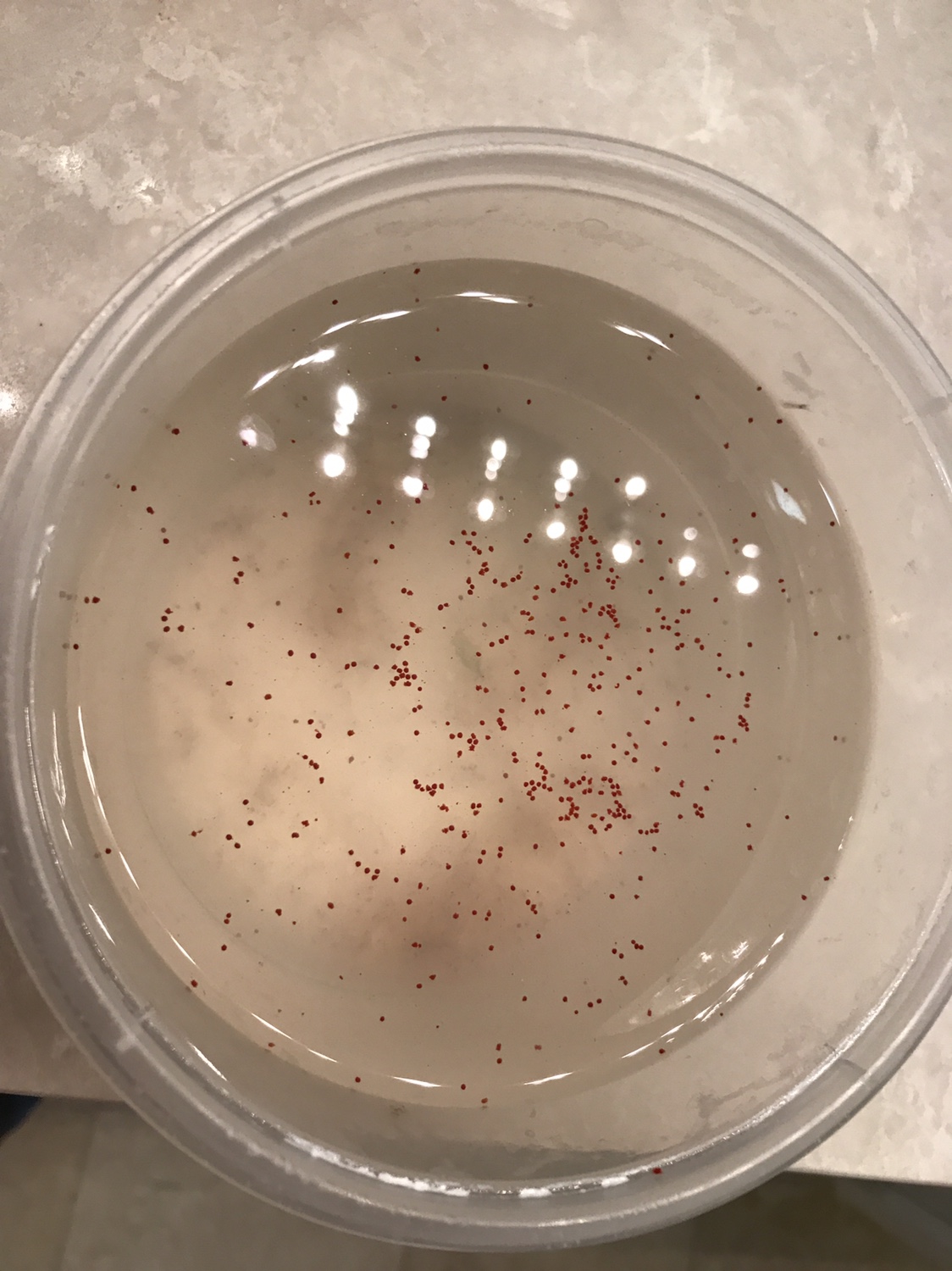
So I put my to tubastria in a Tupperware today with myisis shrimp and I found all these orange dots not sure what they are. Thanks Rich
Some coral, Tubastrea included, spawn when stressed. Moving them to a container with no flow can sometimes cause this... it's a last-ditch effort to reproduce as the coral instinctually believes it's in danger. Silly things don't know we're about to load them up with food
I've seen it happen a few times to Tubastrea and similar coral, along with Euphyllia.
- Joined
- Apr 19, 2017
- Messages
- 103
- Reaction score
- 50
I've seen dendro's being purposely left in a massive refugium as it wasn't doing too great in the tank above it, and how they've grown and survived after fact!!! Mind you there was no target feeding but mainly being constantly fed by refugium pods. Makes me wanna start all over again with Dendros.
So in the last couple months I've been target feeding Reef Roids to the Dendros and other LPS corals and I have noticed a huge boom in the amphipod population. I've also noticed the amphipods crawl all over the tentacles and do in fact steal the some of the food while tentacles do not really grab the amphipods.
Yea natural feeding is really amazing.
Doing it upside down with a feeding tube (called Lunar Lander) works good too.
Purpose of Thread:
This is a brief description in "Laymans Terms" of how to feed and keep large polyp non-photosynthetic corals (NPS coral). I see countless threads and questions regarding "how to feed my new sun coral", or "how do I get the polyps on my new sun coral to open?" They're honestly a relatively easy coral to keep, some just require a little TLC. The following process can be followed for any large polyp non-photosynthetic coral Genus, such as Tubastrea ("Sun Coral"), Dendrophyllia ("Dendros"), Balanophyllia ("Balanos"), etc.
Introduction:
Large polyp NPS coral are pretty much the easiest NPS corals to keep in that they're relatively forgiving in regards to water quality and can go much longer between feedings compared to their other NPS counterparts such as gorgonians and "soft" NPS coral. Most only require feedings a couple times per week or so, but all will grow faster if fed more frequently. They all prefer meaty foods such as brine shrimp, Mysis shrimp, krill, silversides, squid, clams and things of that type. Pieces of any of the aforementioned foods should be of suitable size for the polyp you're feeding; For example you wouldn't want to feed a polyp of Tubastrea coccinea a full silverside, but you could cut it up into very small pieces and make their day
Adding to Aquarium and Feeding:
First acclimate your new NPS coral as you would any coral, inspect for pests, and dip accordingly. There are several predators that feed exclusivlely on a certain NPS coral such as nudibranchs and snails, and the predator will generally retain the color of the Species they eat. I recommend quarantining (QT) all new incoming corals or fish, so that should be your next step if you QT new acquisitions. Once in the QT (or display if you skip QT) feed the tank as you would any day and watch for the polyp(s) on the NPS coral to open. If they open, feed 'em! Keep in mind that the polyps do not need to be fully extended! If you see even one lilttle tentacle peeking out of the coralite feed it, and then the polyp will begin to fully open in due time. In my opinion spot-feeding is the best means to feed these guys as it's easy to control how much food is going into the tank and ensure that no food goes to waste by having all the food go into a polyp, rather than scatter throughout the tank and create excess nutrients. Personally I use a "KENT SeaSquirt" to feed; Pull the little tiny end off of it, sometimes you have to cut it off as some of them are glued, then you can feed meaty foods with them rather than just liquids. I have several of them, two with different bends to feed in hard to reach places, and one straight one (to bend them, heat over the small extension over the stove for a minute and gently bend it). Turkey Basters work great too, along with eye droppers from the drug store for very small foods. It is important to attempt to feed every polyp! It's thought that the colony only shares "stored" energy; Large polyp NPS coral stores Nitrogen and Phosphorous within the skeletal body, which is one way they survive long transit times. It can be tedious, but you will develop a routine that should only take a few minutes. I have over two hundred individual mouths to feed, some very small, some larger (depending on species) and I can feed every single one of them in under fifteen minutes.
One thing to watch for while keeping large polyp NPS coral, especially keeping many of them, is high (detrimental) nutrient levels. As with any aquarium you have to make sure that your nutrient import (feeding, source water, etc.) equals your nutrient export (water changes, skimmers, denitrators, probiotic systems, etc.). Many people who keep NPS only tanks utilize probiotic systems (me included) in order to keep nutrients at bay, although this is by far a necessity, as any means will work as long as you keep parameters in check. This is however one reason I highly recommend spot-feeding rather than broadcast feeding as you can control the food rather than letting it loose in the water column. Large polyp NPS coral are not as finicky when it comes to Phosphate and Nitrate levels as say, Acropora Species are, although if Phosphate levels are allowed to climb too high it will inhibit calcification as with any true (calcifying) coral. If Nitrate levels are allowed to climb too high it will start to cause tissue recession and eventual death.
Polyps Won't Open?!?:
Sometimes the polyps won't open for you initially. Wait a day or two and let them settle in to see if they open, if they don't after the third day you'll want to take action to get nutrients to the coral a.s.a.p. It's now time for the tupperware method. This involves removing the colony from the tank and placing it into a small tupperware container with water from the main tank. Place some "stinky" food in the tupperware like a cube of brine shrimp, cyclopeeze or some mysis shrimp. Let the coral sit in the tupperware for at least fifteen minutes and watch for the polyps to start extending. If they do, feed them! If not, add a bit more stinky food to the tupperware and wait a while longer. Keep in mind if you move the coral or tupperware at all while waiting, the polyps will likely not extend for you (let them sit!). Here is a picture of a colony of Tubastrea undergoing the tupperware method (picture by zaraemna):
I've let a colony sit for over an hour soaking in the tupperware with no ill effects generally they will open after fifteen minutes or so though. If for some reason the coral doesn't extend it's polyps at all, gently shake any food off the coral, remove from the tupperware and place back into the aquarium. Try again in a day or so and eventually it will open for you, unless it's beyond recovery, in which case it will die. I've never had or seen this happen though, even with the roughest looking specimens. Generally the tupperware method only needs to be done with corals of the Genus Tubastrea as in my experience they come in looking mighty rough sometimes compared to their other NPS counterpart why you might ask? Most other large polyp NPS corals cost a pretty penny compared to Tubastrea Species (which really are a dime a dozen), therefore they come through the distribution line fairly quickly whereas Tubastrea will be collected by the diver, taken/shipped to the exporter, then shipped to the importer, then shipped to the wholesaler (sometimes is the importer), then shipped to the retailer where they often sit a considerable amount of time, then bagged up and taken home. Generally during that entire period they are never once fed, leading to them being starving by the time we get them and reluctant to open for feeding (takes energy to open and feed). But follow the tupperware method and you'll have a happy, healthy coral in no time!
Do I HAVE TO Spot Feed These Corals?
The short, simple answer is yes. If you do not want to take the time/effort to spot feed these corals, please do not buy them, no matter "how pretty" the orange or yellow colors may be. Plus... it's FUN to feed them! I get the most enjoyment out of the hobby while feeding all of my large polyp NPS coral, which is the reason I only keep them now! You will occasionally see people who keep them that do not spot feed them. These hobbyists do a variety of things that allow them to be successful with these corals that most hobbysist do not, or cannot do (yet). Some have copious amounts of live food available in the water column and rockwork such as copepods, mysid shrimp, etc. which actually provide excellent, constant food sources for the large polyp NPS corals. If you have a very mature, diversified tank, chances are you'll have to feed these corals very little unless you have fish that wipe out the population of live food sources. Other hobbysists feed their fish copious amounts of food, and between the particulate matter (excess foods) caught in the water column along with detrius and fish feces the NPS coral are able to thrive without direct feedings. Most of the above is to be mentioned strictly regarding Tubastrea and some Dendrophyllia Species... Balanophyllia and other NPS Genuses will be hard pressed to even live without direct feedings.

Do They Have To Be Mounted/Kept in the Dark?
This is a common misnomer regarding large polyp NPS coral, and the answer (with some restrictions) is no! Most of the large polyp NPS coral we see (Tubastrea and Dendrophyllia) are outcompeted by photosynthetic coral in that they grow sooo much slower than their photosynthetic counterparts and are overgrown by them, therefore they must reside in the depths. I have personally seen Tubastrea faulkneri while diving with polyps fully open in bright sunlight in only ten feet of water! Also, in nature these corals are obviously not spot fed by a turkey baster, they rely on Zooplankton and other small critters to feed on, which only come out of the rocks at night! This is why many newly imported large polyp NPS corals will only extend their polyps at night. On that note however, surprisingly some NPS are light sensitive, take Balanophyllia Sp. for example. Any of them that are light sensitive should be kept in a very low light tank, or under overhangs so you can still enjoy the beauty of them when they open. One well known hobbyist even stated that her Balanophyllia closes up (after open once the lights are off) if she turns the TV on in the same room!
Thank you for write up, comrade
Hi guys. I decided to add my experience with Tubastrea to this thread.
I'll start over. I bought Tubastrea at the store for a third of the price, because she was in very poor condition and the polyps did not open since receiving the coral for 2 weeks.
I read about the method of pulling coral from water and feeding, but decided not to use this method.
I came up with another method, maybe someone will come in handy.
I took a magnetic glass cleaner from my old aquarium. On the wet side of the magnet, I glued coral with polyps to the top with epoxy glue.
The usual coral placement was at the bottom of the tank.
When the feeding time approached, I moved magnet with coral to the surface itself, turned off the flow pumps and fed each head in advance with thawed krill and made sure that the fish did not steal food.
Even if they stole, then the victim polyp received a new piece.
The fact is that when the coral is hungry for a long time, it eats up all its reserves, including mucus on the tentacles and is not able to eat on its own (to catch food).
At first (I fed it for 2 months) it is worth feeding daily so that the coral returns to normal and restores its natural way of eating. After that, you can remove it from the magnet (if it interferes) and install it in the place chosen for it and switch to 2-3 single feeding.
I'll start over. I bought Tubastrea at the store for a third of the price, because she was in very poor condition and the polyps did not open since receiving the coral for 2 weeks.
I read about the method of pulling coral from water and feeding, but decided not to use this method.
I came up with another method, maybe someone will come in handy.
I took a magnetic glass cleaner from my old aquarium. On the wet side of the magnet, I glued coral with polyps to the top with epoxy glue.
The usual coral placement was at the bottom of the tank.
When the feeding time approached, I moved magnet with coral to the surface itself, turned off the flow pumps and fed each head in advance with thawed krill and made sure that the fish did not steal food.
Even if they stole, then the victim polyp received a new piece.
The fact is that when the coral is hungry for a long time, it eats up all its reserves, including mucus on the tentacles and is not able to eat on its own (to catch food).
At first (I fed it for 2 months) it is worth feeding daily so that the coral returns to normal and restores its natural way of eating. After that, you can remove it from the magnet (if it interferes) and install it in the place chosen for it and switch to 2-3 single feeding.
Do tubastrea feed on small particles like what's in EasyReef EasySPS, or do they need the larger meatier foods?
From CoralVue:
EasySPS EVO contains particles ranging from 0.2 – 400 microns. EasySPS EVO is composed of Palaemonetes varians, Tetraselmis, Isochrysis, and Phaeodactylum.
I'm also dosing the EasyReef Booster, but that's a phyto product.
TIA
From CoralVue:
EasySPS EVO contains particles ranging from 0.2 – 400 microns. EasySPS EVO is composed of Palaemonetes varians, Tetraselmis, Isochrysis, and Phaeodactylum.
I'm also dosing the EasyReef Booster, but that's a phyto product.
TIA
Even red sea energy AB+, works. Just spot feed when it opens.Do tubastrea feed on small particles like what's in EasyReef EasySPS, or do they need the larger meatier foods?
From CoralVue:
EasySPS EVO contains particles ranging from 0.2 – 400 microns. EasySPS EVO is composed of Palaemonetes varians, Tetraselmis, Isochrysis, and Phaeodactylum.
I'm also dosing the EasyReef Booster, but that's a phyto product.
TIA
Can someone please clarify what is meant by the use of probiotic systems? I would really love to know more but haven't had any luck finding more information.
vetteguy53081
Well known Member and monster tank lover
View Badges
Partner Member 2024
Excellence Award
Reef Tank 365
RGB
Article Contributor
Tampa Bay Reef Keepers
West Palm Beach Reefer
Hospitality Award
Ocala Reef Club Member
305 Reef Club
Wisco Reefers
Midwest Reefer
Fish Medic
MAC of SW Florida
Rock Pool Reef Keepers
R2R Secret Santa 2023
My Tank Thread
My Aquarium Showcase
Besides helping the fish immune system.... Probiotics for Saltwater Aquarium helps promote optimal water quality by implementing probiotic bacteria that will keep your tank balanced with a 100% natural solution.
aquaforest has a full line
aquaforest has a full line
Awesome!Besides helping the fish immune system.... Probiotics for Saltwater Aquarium helps promote optimal water quality by implementing probiotic bacteria that will keep your tank balanced with a 100% natural solution.
aquaforest has a full line
I have a few NPS and plan to add to them eventually, so I will certainly be looking into this.
Thank you very much!
Daniel@R2R
Living the Reef Life
View Badges
Staff member
Super Moderator
Reef Squad
Partner Member 2024
Excellence Award
Photo of the Month
Article Contributor
Hospitality Award
Article Administrator
Reef Pumpkin Carver
R2R Secret Santa 2023
My Tank Thread
Great discussion on NPS! Bumping this one back up!
vetteguy53081
Well known Member and monster tank lover
View Badges
Partner Member 2024
Excellence Award
Reef Tank 365
RGB
Article Contributor
Tampa Bay Reef Keepers
West Palm Beach Reefer
Hospitality Award
Ocala Reef Club Member
305 Reef Club
Wisco Reefers
Midwest Reefer
Fish Medic
MAC of SW Florida
Rock Pool Reef Keepers
R2R Secret Santa 2023
My Tank Thread
My Aquarium Showcase
Nice sun colonyIve had these guys for about a year now.
Similar threads
- Replies
- 20
- Views
- 437
New Posts
-
-
-
Maco aquascape bonding, I have my planned method, what's your
- Latest: ShakeyGizzard
-





